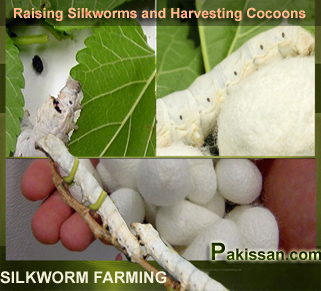|
 Silkworms
are really not worms at all. silk worms are the
larvae of ‘bombyx mori’ moths and silkworms are
actually domesticated insects. Silkworms
are really not worms at all. silk worms are the
larvae of ‘bombyx mori’ moths and silkworms are
actually domesticated insects.
Native
to china, the silkworm does not longer exist in the
wild, after so many centuries of inbreeding the
silkworm is incapable of flight, mates quickly after
emerging from its crysalis, and dies a day or so
after laying its eggs.
Design
boom illustrates the several stages of sericulture,
which begins with hatching silkworm eggs ...
An ounce of silkworm eggs yields about 35,000 worms,
during gestation, which lasts approximately three
weeks, the eggs must stay between 25 and 31 °C, in a
tray with high humidity.
As they hatch, each of the tiny creatures must be
carefully moved to a ‘petri dish’, a circular flat
bamboo tray, to be fed with fresh mulberry leaves
several times a day.
When the baby silkworms emerge from their eggs, they
are really tiny, about the size of a lowercase ‘i’,
and almost black. From the moment they emerge they
start eating with an enthusiasm that never abates.
When design boom entered the farmer’s household we
could hear them constantly chewing. The worms are
protected from harmful flying insects by wrapping
the trays in homespun cotton.
The newly born silkworm only eats mulberry leaves. a
silk farmer must have a ready supply of mulberry
leaves and fruits close at hand, even one missed
feeding can kill the sericulture. there are times of
the year when the mulberry leaves are not around...
continued food shortages can decrease the quality of
silk any survivors make.
If there are shortages anyway, lettuce makes a
decent emergency dish, as long as it is well-washed
(pesticides kill) and dried thoroughly.
Despite revolutionary changes in methods of
manufacture, the ultimate basis of silk remains the
tiny, inconspicuous-looking silkworm and the most
critical period in silk production comes during the
silkworm’s brief life span of around 20/24 days.
Nearly all silkworm-producing moths belong to the
family ‘bombycidae’, of which one member, ‘bombyx
mori’ is responsible for most of the world’s silk.
At the beginning every few days, the worms need to
be moved to a clean tray with fresh food.
Members of the farmer’s household must spend a
growing amount of time to their bamboo trays, also
because silkworms produce quite a lot of excrement
and cleaning the trays is not a job for the
weak-stomached.
They continue feeding and moving the silkworms,
dividing the colonies when the silkworms are too
large or hungry for the numbers in that tray. by the
fourth week, the largest of the silkworms will be
more than 5 cm. long, fat, and hungry enough that
they need to be fed every day.
An easy test confirms their readiness to cocooning.
the farmer picks them up and looks between their
rear pair of legs, from the underside. if there is a
gray mass there, the caterpillar isn't quite ready,
but if it's milky and translucent, the silkworm has
pooped its last and is definitely ready.
The worms suddenly stop eating and raise their heads
- another sign that they are ready for the
all-important job of spinning cocoons.
At that stage they are removed from their feeding
trays.
The ‘bombyx mori’ worms are now inserted in a
specially woven circular bamboo scaffolding, which
will make the cocoons more uniform in shape and
easier to collect.
Again, worms are protected from harmful flying
insects by wrapping the trays with fine nets. There
seems to be always a few dead silkworms in each
tray.
While a dramatic
increase in the mortality rate is reason for
concern, silkworms are insects, and farmers can
expect that less than half of the silkworms will
reach full maturity.
Each silkworm now doubles itself up on its back, and
by contracting secretes, from an opening under its
mouth, a steady stream of liquid silk, coated with
sericin, which hardens on exposure to air.
They're starting to lay
out the support strands for their cocoons, although
they may not yet be serious about cocooning.
Some of the larger caterpillars are climbing the
walls of the tray (they've done this before, to shed
their skins, but this time their heads are pointing
toward the lid) and the busy silkworms are guided by
figure of eight movements of their heads, to dispose
the liquid silk in layers, forming the cocoon.
After some 36 hours, the worms are sealed within a
yellow cocoon, embarked on the process of
metamorphosing into a moth.
The worms have spun thousands of gossamer little
cocoons.
The satisfactory cocoons are now in a clean tray.
see the lustrous, golden color. Care must be taken
not to damage them when removing from the old trays.
The entire process, from
silkworm egg to complete cocoon, takes about
twenty-five days. Silk worms transform themselves,
inside the cocoon, into a chrysalis and then into a
butterfly...
Most of the cocoons are used for the next step in
silk making but some of them leave the cocoon as a
butterfly. it usually secretes a liquid onto the
silk threads to dissolve them, so it can emerge.
The new moths must be
moved to another tray so the mess they make while
mating and laying eggs doesn't get all over the
hard-earned silk cocoons. The males (small) will die
once the deed is done, while the females will stick
around to lay about 200 - 300 eggs each.
Courtesy:
Design Boom
|
Pakissan.com;
|